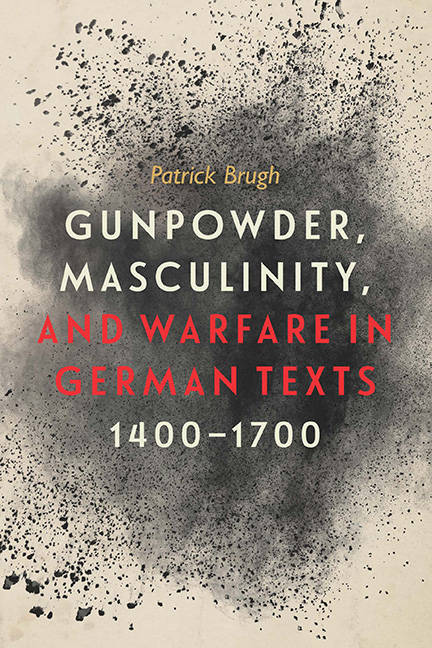Book contents
- Frontmatter
- Dedication
- Contents
- List of Illustrations
- Acknowledgments
- A Note on Translation and Spelling
- Abbreviations
- 1 A Tale of Two Suits of Armor
- 2 Of Hussites and Haystacks, of Questions and Cannons
- 3 Textbook War: The Genealogy of Kriegsbücher
- 4 Gunpowder Dilemmas and Loaded Peace in Fronsperger's Kriegsbuch
- 5 Depicting Gunpowder in German Military Broadsheets (1630–32)
- 6 Gustav Adolf's Gunpowder Demise
- 7 The Aesthetics of Gunpowder in Seventeenth-Century German War Novels
- 8 Cavalier Endings in Happel's Der insulanische Mandorell (1682)
- Appendix: Comparisons of Broadsheets from Battles of Breitenfeld, Rain am Lech, and Lützen
- Notes
- Bibliography
- Index
7 - The Aesthetics of Gunpowder in Seventeenth-Century German War Novels
Published online by Cambridge University Press: 25 March 2020
- Frontmatter
- Dedication
- Contents
- List of Illustrations
- Acknowledgments
- A Note on Translation and Spelling
- Abbreviations
- 1 A Tale of Two Suits of Armor
- 2 Of Hussites and Haystacks, of Questions and Cannons
- 3 Textbook War: The Genealogy of Kriegsbücher
- 4 Gunpowder Dilemmas and Loaded Peace in Fronsperger's Kriegsbuch
- 5 Depicting Gunpowder in German Military Broadsheets (1630–32)
- 6 Gustav Adolf's Gunpowder Demise
- 7 The Aesthetics of Gunpowder in Seventeenth-Century German War Novels
- 8 Cavalier Endings in Happel's Der insulanische Mandorell (1682)
- Appendix: Comparisons of Broadsheets from Battles of Breitenfeld, Rain am Lech, and Lützen
- Notes
- Bibliography
- Index
Summary
Speaking properly, I must say that manliness and bravery are no longer commonly practiced in the activities of war.
—Leonard Fronsperger, KriegsbuchLiterary texts tell us how war was imagined, even if not precisely how it was practiced. And texts on war help us to think about it in cultural terms, even if claims about historical change must be advanced carefully. This chapter looks at the representation of gunpowder weapons in the war novels of Johann Michael Moscherosch (1601–69) and H. J. C. Grimmelshausen (1621/22–76), two esteemed seventeenth-century German authors, each of whom experienced the Thirty Years War in an up-close and personal way and also served in local governmental administrative positions in the aftermath. The Thirty Years War ended with remarkable consequences for Europe in general and German-speaking lands specifically in terms of human cost, destruction of towns and infrastructure, and the general demoralization of the population. Peter H. Wilson does the most comprehensive job of surveying the human and material costs of the Thirty Years War in his mammoth history of the conflict. Certainly in the aftermath from the late stages of the war until today, as Wilson notes, “The sense of the Thirty Years War's destructiveness remains deeply embedded in the popular consciousness.” The actual degree of destruction has been under debate for some time, but both German people and international witnesses largely interpreted the destruction caused by the conflict as tectonic.
The interpretation of death and destruction caused by the war depends largely on where one looks and how one calculates loss. Some towns were almost entirely demolished, like—infamously—Magdeburg. Halberstadt, which fell along a major trade route, lost around 80 percent of its population between 1625 and 1648. About half of the villages in Brandenburg were empty at one point during the war. A few German cities went virtually unscathed or even grew a little bit. Other areas suffered deep losses but rebounded quickly. People fleeing violence often found a new home elsewhere out of harm's way by escaping as refugees. That said, as we have seen as a result of conflicts in Africa and the Middle East, most notably the Syrian and Libyan crises since 2011, even the displacement of humans to otherwise stable regions wreaks havoc on the economic and social fabric of places not directly touched by violent conflict.
- Type
- Chapter
- Information
- Gunpowder, Masculinity, and Warfare in German Texts, 1400–1700 , pp. 150 - 183Publisher: Boydell & BrewerPrint publication year: 2019



